If the answer is 'boulevards' then what was the question?
South Wales Evening Post - 16 July 2013
"SO how many business people do you know who approve of this boulevard scheme", I said to the Evening Post editor pointing out his office window at workers excavating the stretch between Oystermouth Road and Quay Parade.
Don't get me wrong. I'm not precious about digging up the city. A few people might recall that I'm the guy who wanted to redevelop the land between High Street and the Kardomah to create a shopping mall that would have put 30% of the city's shopping area under cover. I don't have a problem about breaking eggs to produce a decent omelette.
Maybe I come with a slightly different perspective to your average critic. Besides my own project involvement I also have 20-something years background in local government. So I understand that the public sector is driven by priorities. My question is how did the boulevard scheme ever become a priority?

Boulevards or barriers : When did this become a priority?
The new administration which took over last year at Swansea's civic centre pledged to create a healthy and vibrant city centre by ending "traffic-led planning and investment". I put this point to Nick Bradley, who has the job of furthering Swansea's economic ambitions at what must be one of the toughest times for local government.
The nature of council finance is that money for large infrastructure schemes comes from the Welsh Government. Councils have to bid against each other to get the necessary funds. The city has a good success rate but the outcomes are what I'd call erratic. For example, Swansea is the only place I know that managed to spend millions on straightening city centre roads to accommodate articulated bendy-buses.
Mr Bradley admits that much of the present £7 million phase of the boulevard scheme is being spent upgrading areas that were only recently improved. His problem is that the project was already well advanced when he took up office. There were only limited options for change and the risk was that delays would mean losing the money altogether. There was also the possibility of claims from firms already contracted to do the work.
His outlook is that the focus is now about creating the right linkages in advance of creating new attractive destinations. I find this an admirable but risky proposition at a time when public sector austerity means greater reliance on private investment. Markets have an uncanny way of deciding for themselves as to the best commercial location. One instance is how Aspers decided to close up shop in Swansea despite the city earlier landing a 'super casino' license.
Show me someone who says city centre regeneration isn't about footfall and I'll show you someone with an empty shop. The key is always going to be about enabling people to get to where you want them to be. That's why the bus station is sited right alongside the Quadrant Centre. That's why Tesco fought so long and hard to get planning consent for their Marina store.
In my opinion, the boulevard project is the wrong kind of scheme in the wrong place at the wrong time. It is essentially about enhancing an east-west corridor that was already attractive. No-one I've spoken to in the business community thinks it will generate trade or boost future investment.
The challenge is that we still need to create new footfalls and open up the city's waterfront to residents and visitors. My suggestion is for an elevated walkway connecting Wind Street and Somerset place but I'm sure there are plenty of other ideas out there.